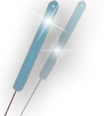| ||||||||||||||||
|
| ||||||||||||||||||||||||||||||||||||
| |||||||
Behavioral treatments
Many physicians believe that exercise for 15–20 minutes per day is helpful for reducing the frequency of migraines.
Sleep is often a good solution if a migraine is not so severe as to prevent it, as when a person awakes the symptoms will have most likely subsided.
Diet, visualization, and self-hypnosis are also alternative treatments and prevention approaches.
Sexual activity has been reported by a proportion of male and female migraine sufferers to relieve migraine pain significantly in some cases.
In many cases where a migraine follows a particular cycle, attempting to interrupt the cycle may prolong the symptoms. Letting a headache "run its
course" by not using painkillers can sometimes decrease the length of an episode. This is especially true of cases where vomiting is common, as
often the headache will subside immediately after vomiting. Curbing the pain may delay vomiting, and prolong the headache.[citation needed]
Alternative medicine
A number of forms of alternative medicine, particularly bodywork, are claimed to help prevent migraines.
Some preliminary clinical trials have suggested that chiropractic care may be an efficacious treatment for migraine headaches[54][55] These initial
studies are limited by lack of control subjects, poor control subjects, lack of blind study design, small sample sizes, and other methodological flaws.
[56] A review of the literature until 2004 found that "Chiropractic manipulation demonstrated a trend toward benefit in the treatment of TTH, but
evidence is weak. ... In the absence of clear evidence regarding their role in treatment, physicians and patients are advised to make cautious and
individualized judgments about the utility of physical treatments for headache management; in most cases, the use of these modalities should
complement rather than supplant better-validated forms of therapy.
Testimonials
Click here to schedule an appointment in Manhattan or Queens NY or/and send alternative medicine and healing without medications acupuncture
specialist your health question or call "Feel Good Acupuncture" at 646-327-7267.
Many physicians believe that exercise for 15–20 minutes per day is helpful for reducing the frequency of migraines.
Sleep is often a good solution if a migraine is not so severe as to prevent it, as when a person awakes the symptoms will have most likely subsided.
Diet, visualization, and self-hypnosis are also alternative treatments and prevention approaches.
Sexual activity has been reported by a proportion of male and female migraine sufferers to relieve migraine pain significantly in some cases.
In many cases where a migraine follows a particular cycle, attempting to interrupt the cycle may prolong the symptoms. Letting a headache "run its
course" by not using painkillers can sometimes decrease the length of an episode. This is especially true of cases where vomiting is common, as
often the headache will subside immediately after vomiting. Curbing the pain may delay vomiting, and prolong the headache.[citation needed]
Alternative medicine
A number of forms of alternative medicine, particularly bodywork, are claimed to help prevent migraines.
Some preliminary clinical trials have suggested that chiropractic care may be an efficacious treatment for migraine headaches[54][55] These initial
studies are limited by lack of control subjects, poor control subjects, lack of blind study design, small sample sizes, and other methodological flaws.
[56] A review of the literature until 2004 found that "Chiropractic manipulation demonstrated a trend toward benefit in the treatment of TTH, but
evidence is weak. ... In the absence of clear evidence regarding their role in treatment, physicians and patients are advised to make cautious and
individualized judgments about the utility of physical treatments for headache management; in most cases, the use of these modalities should
complement rather than supplant better-validated forms of therapy.
Testimonials
Click here to schedule an appointment in Manhattan or Queens NY or/and send alternative medicine and healing without medications acupuncture
specialist your health question or call "Feel Good Acupuncture" at 646-327-7267.
Attack
When untreated, a migraine typically lasts from four to 72 hours, but the frequency with which headaches occur varies from person to person. You may
have migraines several times a month or much less frequently. During a migraine, you may experience some of the following symptoms:
Pain on one side of your head
Pain that has a pulsating, throbbing quality
Sensitivity to light, sounds and sometimes smells
Nausea and vomiting
Blurred vision
Diarrhea
Lightheadedness, sometimes followed by fainting
Postdrome
The final phase — known as postdrome — occurs after a migraine attack, when you may feel drained and washed out, though some people report
feeling mildly euphoric.
When to see a doctor
Migraine headaches are often undiagnosed and untreated. If you regularly experience signs and symptoms of migraine attacks, keep a record of your
attacks and how you treated them. Then make an appointment with your doctor to discuss your headaches and decide on a treatment plan.
Even if you have a history of headaches, see your doctor if the pattern changes or your headaches suddenly feel different.
See your doctor immediately or go to the emergency room if you have any of the following signs and symptoms, which may indicate other, more
serious medical problems:
An abrupt, severe headache like a thunderclap
Headache with fever, stiff neck, rash, mental confusion, seizures, double vision, weakness, numbness or trouble speaking
Headache after a head injury, especially if the headache gets worse
A chronic headache that is worse after coughing, exertion, straining or a sudden movement
New headache pain if you're older than 50
Testimonials
Click here to schedule an appointment in Manhattan or Queens NY or/and send alternative medicine and healing without medications acupuncture
specialist your health question or call "Feel Good Acupuncture" at 646-327-7267.


